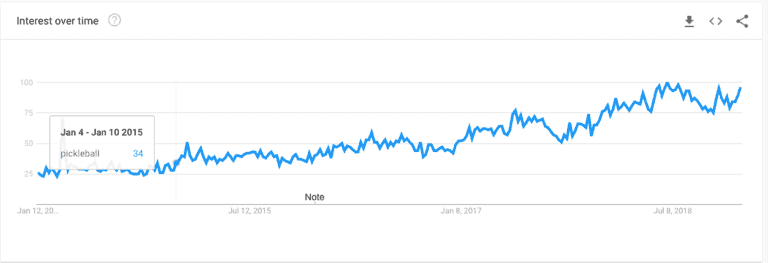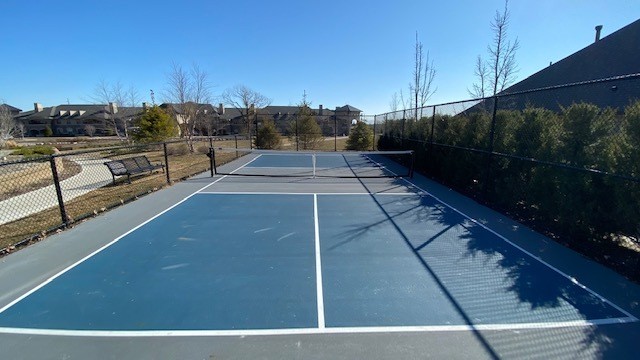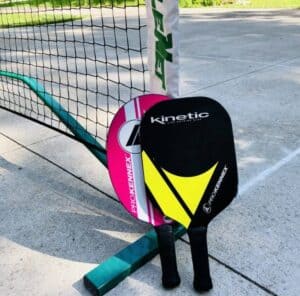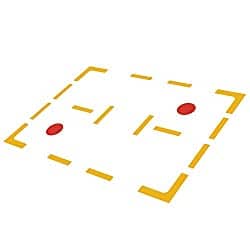A Step-By-Step Guide to Painting Pickleball Lines On A Tennis Court
If you’re looking to turn a tennis court into a pickleball court, there are a few things you’ll need in order to do the job of painting pickleball lines on tennis court; correctly. Making a regulation pickleball court on top of a tennis court is more than just adding lines with white paint to define the shorter boundaries.
Painting pickleball lines on a tennis court entails measuring a 20-foot by 44-foot rectangle, lining it with masking tape, and then painting the lines with white or blue acrylic paint, ideally one with fine sand mixed in to match the texture of an outdoor court surface.
In this article I will discuss the best ways to transform a tennis court into a pickleball court, including tips and tricks for the painting side of the job. Read on to learn how to paint pickleball lines on a tennis court.
Shared Use vs. Dedicated Use of Tennis Court
Pickleball is very similar to tennis, both in how it’s played and in the setup required. Converting a tennis court into a pickleball court is fairly straight forward. You just need to get the small details right.
If you don’t get the small details right, you run the risk of ruining the tennis court, while making a pickleball court that doesn’t meet regulation standards.
I’m here to help you avoid that.
First of all, you will need to decide whether you want to transform your tennis court into a pickleball court permanently or if you want to turn it into a court that can double as both.
If you’re looking to build a court for shared use, meaning that you can play either pickleball or tennis on the same court, you can simply add new lines inside the perimeter of the tennis court and tighten the center strap to bring the net down to 34 inches in the center.
You can also do this with two eye hooks, two expandable sleeves, and tie-down straps.
Related: Click here to learn how pickleball net height is not the same as a tennis net in two distinct spot.
If you’re maintaining a court for shared use between pickleball and tennis, you may also want a removable barrier to shorten the length of the court when it’s being used for pickleball so that you’re not forced to run the whole length of a tennis court to retrieve a stray ball.
If you’re looking to convert tennis courts into dedicated pickleball courts, you can fit quite a few pickleball courts into the same area. Size-wise, it equates to two pickleball courts on each side of a tennis net or four pickleball courts per total tennis court.
Yes, you read that correctly, four.
This is why many public tennis courts are being converted to pickleball courts across the US. As pickleball grows in popularity, the number of tennis courts goes down, and the number of pickleball courts goes up.
In 2021, the total number of pickleball courts nearly hit 9,000 and averaged 67 new courts a month! Data Source: USA Pickleball.

Where To Paint Pickleball Court Lines On A Tennis
A pickleball court is 20 feet wide and 44 feet long, where a tennis court is 36 feet wide and 78 feet long. Only part of the tennis court is used in singles matches, so a tennis court already has lines marking off a smaller inner width of 27 feet.
This makes adding pickleball lines even easier.
The width between this inner line and the court’s outermost edge is what’s known as doubles alley.
If you’re looking to share use of a tennis court between tennis and pickleball games, you’ll want to paint pickleball lines that mark off the width of the court, three and a half feet in from doubles alley on both sides.
If you’re looking to repurpose a tennis court into pickleball courts, you can measure four 20-foot by 44-foot rectangles and position one in each corner of the tennis court.
However, in some cases, you’ll find a tennis court with rounded corners, in which case you can measure two pickleball courts and place them end to end in the center of the original court.
What Paint Should You Use To Paint Pickleball Court Lines On Tennis Court?
There are many options to mark off lines for a pickleball court, but the most long-lasting and durable way is to use paint. The best paint to use is something that matches the texture of the playing surface and doesn’t wear easily.
In most cases, this means acrylic paint fortified with fine sand, like the Textured T/C White Line Paint from SportMaster.
You can also find white athletic field paints that work as spray paints, like the Seymour 20-644 Stripe Athletic Field Marker. If you’re going to use a paint like this one, it’s especially important to put down painting tape ahead of time to avoid any unevenness.
Quick Tip: Most tennis courts have white lines laid down on them so when adding pickleball court lines to a tennis court, it is important to use a different color. This will prevent confusion and make the pickleball baselines clearly visible. My local tennis court has blue lines laid down for the pickleball court and this makes it much easier to distinguish the line patterns.

The Seymour 20-644 Field Marker Paint mentioned above, comes in a wide variety of colors making it easy to distinguish the lines.

Can you see the blue pickleball lines over the white tennis lines?

A standalone pickleball court should always have traditional white lines on the court like shown here.
How To Paint Pickleball Lines on a Tennis Court
If you’re looking to convert a tennis court into a pickleball court or multiple pickleball courts, you’ll need to follow the right steps. That way, you can use the court however you want, whether it’s dedicated to pickleball or shared between tennis and pickleball.
Follow these steps to paint pickleball lines on a tennis court:
- Clean the pavement surface, removing all dirt, dust, and debris.
- Use masking tape to mark off the court lines that you wish to paint.
- Stir the paint if you’re using canned paint.
- Roll or brush a coat of paint on the surface.
- Allow the first coat to dry thoroughly.
- Apply a second coat of paint on the surface.
- Remove tape and allow 48 hours to fully dry.
- Wash painting tools in water before the material dries.
Quick Tip: If you’re looking to use a template for where your lines should go before you paint, temporary pickleball court lines are a great way to help you outline the court you’re about to lay down. I wrote all about how temporary pickleball court lines should be used here.
Additional Tips For Painting Pickleball Lines On A Tennis Court
As you’re preparing to paint pickleball lines on a tennis court, there are several other tips and tricks that you should consider, including the following:
- Only paint when temperatures are above 50 degrees Fahrenheit (10 degrees Celsius), including during the 24 hours after application.
- Do not apply paint if rain is in the forecast.
- Try using a taping machine to make it easier to draw straight, consistent court lines.
- Use a fast-drying aerosol paint to cover inconsistencies or gaps if they appear.
- Use a steel tape measure to figure out where you need to paint, and then set benchmarks in place.
- Consider investing in a paint machine for the cleanest possible lines. If you do use a paint machine, clean it after each application.
- Don’t let any paint drip or run into a storm drainage area, as it may be toxic.
- If you use a paint machine, strain the paint first.
- Know how much paint you’ll need before you get started. This will likely be about one gallon for a typical pickleball court.
- Use the least amount of paint possible to cover the surface.
- Always have a bucket of warm water and rags nearby to wipe up any spills or messes.
Alternatives To Painting On A Tennis Court

Side walk chalk like used here is great for driveway pickleball
If you don’t want to paint or are looking for a temporary way to create a pickleball court, other options are available, whether you’re looking at an indoor court or an outdoor court. Consider the following alternatives:
- Sidewalk chalk, which lasts several weeks
- Thick toddler crayons, which last longer than chalk
- Contractor’s blue chalk dust, available at home improvement stores and best used with an applicator tool
- About 198 feet of frog green tape if the surface isn’t too rough
- Simple masking tape can serve the purpose if the surface isn’t too rough
- Vinyl ‘EZ’ court lines like the Eco Walker Court Line Marker Kit
- Electric black tape, which leaves no residue

Painting Pickleball Lines On A Tennis Court – Conclusion
A tennis court can easily be transformed into a pickleball court or courts, given a bit of paint and an adjustment to the net height. All it takes is acrylic paint and masking tape — measured out to a 20-foot wide to 44-foot long rectangle — and a strap to pull the net down to 34 inches in the middle.

Welcome to TheVolleyLlama.com. My name is Keith, I’m just a lover of all sports that involve a racquet, net and a ball. I played competitive high school varsity tennis, love racquetball and my whole family plays pickleball regularly. I started this website to help give people like you the basics to learn these wonderful games.

